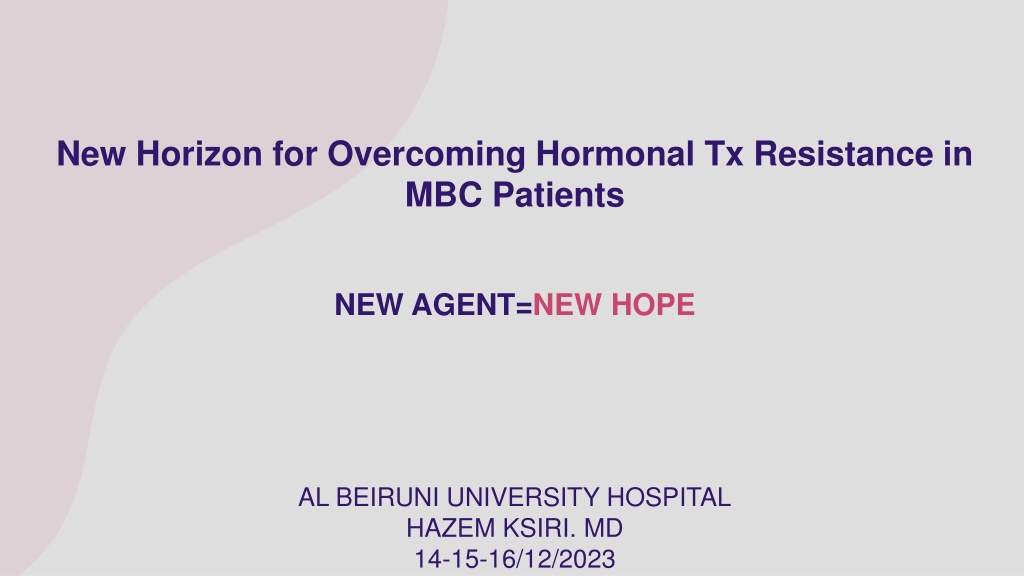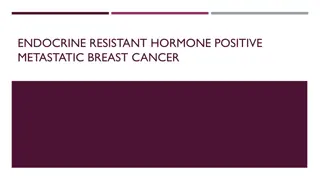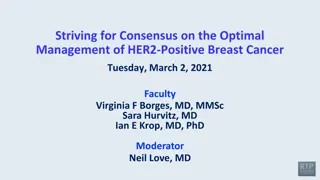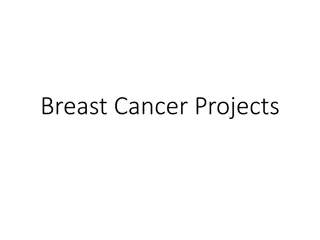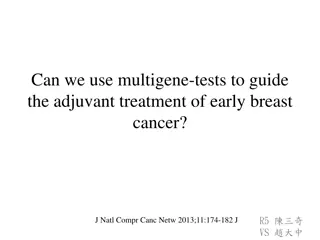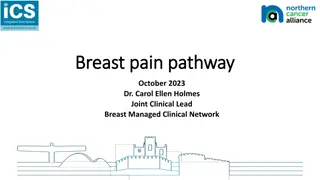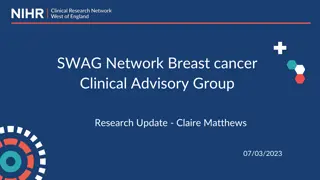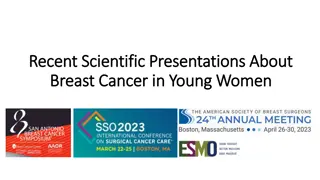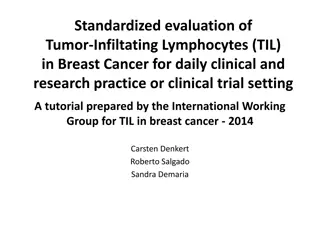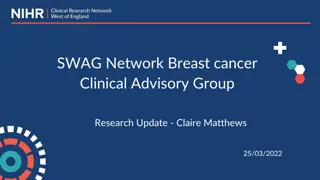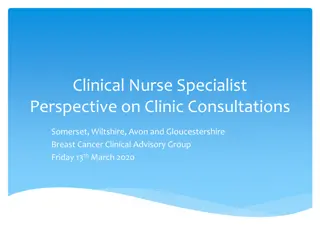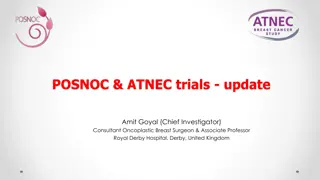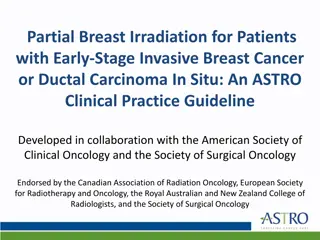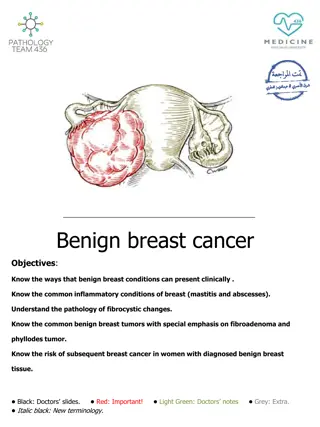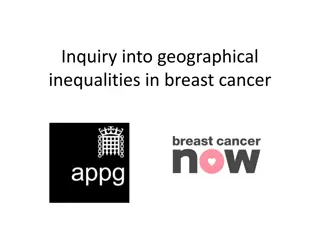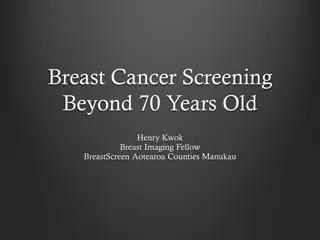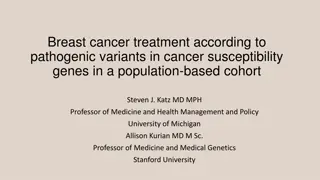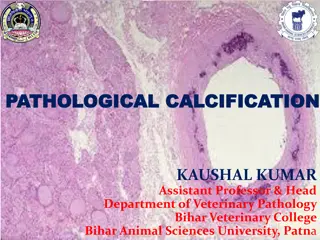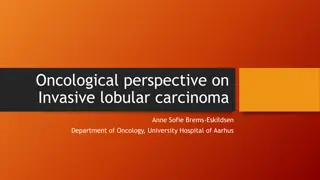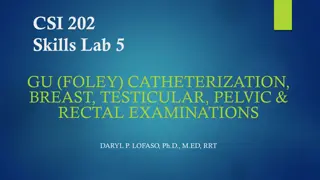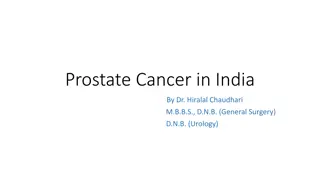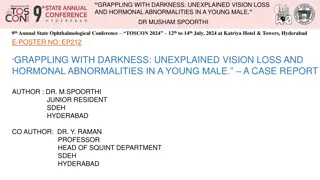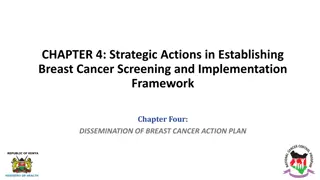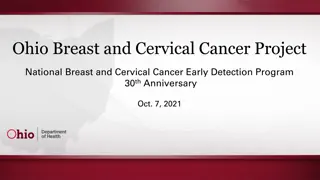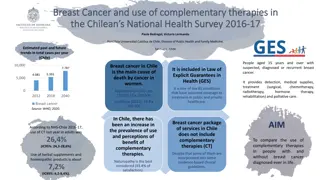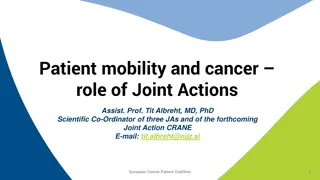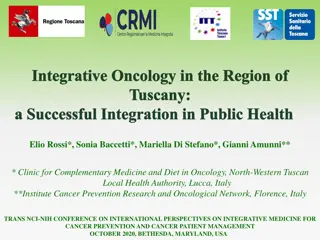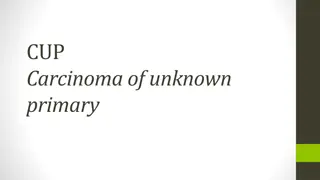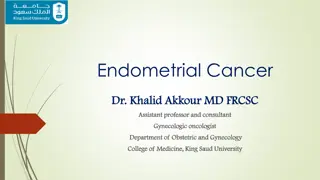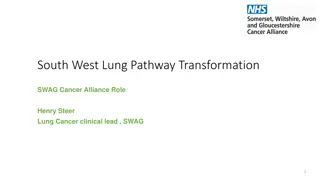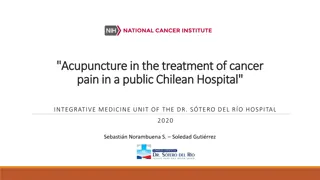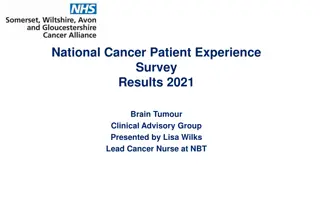New Horizon for Overcoming Hormonal Treatment Resistance in Metastatic Breast Cancer Patients
Breast cancer, particularly estrogen receptor-positive tumors, poses a significant challenge due to endocrine resistance. While endocrine therapy is effective, resistance can occur in both early and advanced stages of the disease. This presentation discusses novel approaches to address this resistance, offering hope for improved outcomes in metastatic breast cancer patients.
Download Presentation

Please find below an Image/Link to download the presentation.
The content on the website is provided AS IS for your information and personal use only. It may not be sold, licensed, or shared on other websites without obtaining consent from the author. Download presentation by click this link. If you encounter any issues during the download, it is possible that the publisher has removed the file from their server.
E N D
Presentation Transcript
New Horizon for Overcoming Hormonal Tx Resistance in MBC Patients NEW AGENT=NEW HOPE AL BEIRUNI UNIVERSITY HOSPITAL HAZEM KSIRI. MD 14-15-16/12/2023
Introduction Breast cancer is the most common cancer disease among women Approximately 70% of all tumors express the estrogen receptor (ER) It s a transcription factor that is activated by estrogen binding and that regulates the expression of various genes involved in tumor formation. Two isoforms exist: ER , which is predominantly expressed in breast cancer and the main target of endocrine therapy ER , which seems to have an opposite effect to ER and inhibits estrogen-dependent cell proliferation Anderson WF, Chatterjee N, Ershler WB, Brawley OW. Estrogen receptor breast cancer phenotypes in the Surveillance, Epidemiology, and End Results database. Breast Cancer Res Treat. 2002 Nov;76(1):27 36. https://doi.org/10.1023/A:1020299707510[PubMed]0167-6806
Introduction Endocrine therapy is one of the most effective treatment options for ER-positive breast cancer. In the metastatic setting, it is the therapy of choice, except in cases of immediately life- threatening disease, i.e., a visceral crisis. Classical endocrine therapies modulate the estrogen effect by blocking the ER (selective ER modulators, SERMs) like tamoxifen. Aim to reduce estrogen levels (e.g., the aromatase inhibitors [AIs] letrozole, anastrozole, and exemestane) should only be used in the postmenopausal situation. Fulvestrant ( SERD) Rugo HS, Rumble RB, Macrae E, Barton DL, Connolly HK, Dickler MN, et al Endocrine Therapy for Hormone Receptor-Positive Metastatic Breast Cancer: American Society of Clinical Oncology Guideline. J Clin Oncol. 2016 Sep;34(25):3069 103.
Introduction A major challenge in treating ER-positive breast cancer is to overcome endocrine resistance. Primary endocrine resistance: Early breast cancer: relapse within 2 years of adjuvant endocrine treatment. Advanced breast cancer or MBC: disease progression during the first 6 months of first-line endocrine therapy. Cardoso F, Senkus E, Costa A, Papadopoulos E, Aapro M, Andr F, et al 4th ESO-ESMO International Consensus Guidelines for Advanced Breast Cancer (ABC 4). Ann Oncol. 2018 Aug;29(8):1634 57. https://doi.org/10.1093/annonc/mdy192[PubMed]0923-7534
Introduction A major challenge in treating ER-positive breast cancer is to overcome endocrine resistance. Secondery endocrine resistance: Early breast cancer: as a relapse that occurs after at least 2 years of endocrine therapy and during or within the first year of completing adjuvant endocrine therapy. Advanced breast cancer or MBC: defined as disease progression after more than 6 months of endocrine therapy. Cardoso F, Senkus E, Costa A, Papadopoulos E, Aapro M, Andr F, et al 4th ESO-ESMO International Consensus Guidelines for Advanced Breast Cancer (ABC 4). Ann Oncol. 2018 Aug;29(8):1634 57. https://doi.org/10.1093/annonc/mdy192[PubMed]0923-7534
Mechanisms of Endocrine Resistance Receptor Tyrosine Kinases Family of cell membrane-bound receptors [EGFR/ErbB family] [IGFR] [VEGFR] [FGFR] Cell Cycle Regulators cyclin D/cyclin-dependent kinases (CDK) 4/6 pathway ESR1 Mutations Rugo HS, Rumble RB, Macrae E, Barton DL, Connolly HK, Dickler MN, et al Endocrine Therapy for Hormone Receptor-Positive Metastatic Breast Cancer: American Society of Clinical Oncology Guideline. J Clin Oncol. 2016 Sep;34(25):3069 103.
ESR1 Mutations Rare in primary breast cancer High prevalence (20 40%) in patients with MBC who have previously received endocrine treatment Most mutations (D538G, Y537S, Y537N, Y537C, and E380) Occur at hot spots in the ligand-binding domain of ER resulting in constitutive ER activity. BOLERO-2 trial - SoFEA trial Chandarlapaty S, et al Prevalence of ESR1 Mutations in Cell-Free DNA and Outcomes in Metastatic Breast Cancer: A Secondary Analysis of the BOLERO-2 Clinical Trial. JAMA Oncol. 2016 Oct;2(10):1310 5. Hayward L, et al; SoFEA investigators Fulvestrant plus anastrozole or placebo versus exemestane alone after progression on non-steroidal aromatase inhibitors in postmenopausal patients with hormone-receptor-positive locally advanced or metastatic breast cancer (SoFEA):. Lancet Oncol 2013
ESR1 Mutations Systemic Treatment First line therapy( for postmenopausal or premenopausal receiving ovarian ablation or suppression) AI+ CDK4/6 Inhibitors (+/- Bisphosphonate) (preferred) for her2- negative (see Eligibility Criteria) Fluvestrant + CDK 4/6 Inhibitors (preferred) for her2- negative (see Eligibility Criteria) Aromatase inhibitors TAM Endocrine therapy ( for HR- positive): second line therapy( for postmenopausal or premenopausal receiving ovarian ablation or suppression) (According to available medications) (BC that have at least 1% of cell stainig positive for HR should be considered HR- Positive) Fluvetrant + CDK4/6 Inhibitors(If CDK4/6 inhibitors not previously used ( preferred). Fuvestrant + Alpelisib for PIK3CA mutated tumors (Preferred 1). Everolimus + Endocrine therapy. Aromatase Inhibitors. Selective ER down-regulation (Fluvestrant). Selective estrogen receptor modulator ( Tamoxifen or Toremifene).
Elacestrant (oral selective estrogen receptor degrader) Versus Standard Endocrine Therapy for Estrogen Receptor Positive, Human Epidermal Growth Factor Receptor 2 Negative Advanced Breast Cancer: Results From the Randomised Phase III EMERALD Trial Randomized, open-label, active-controlled, multicenter trial Francois-Clement Bidard, MD1,2; Virginia G. Kaklamani, MD3; Patrick Neven, MD4; Guillermo Streich, MD5; Alberto J. Montero, MD6; Fr ed eric Forget, MD7; Marie-Ange Mouret-Reynier, MD8; Joo Hyuk Sohn, MD9; Donatienne Taylor, MD10; Kathleen K. Harnden, MD11; Hung Khong, MD12; Judit Kocsis, MD13; Florence Dalenc, MD14; Patrick M. Dillon, MD15; Sunil Babu, MD16; Simon Waters, MD17; Ines Deleu, MD18; Jos e A. Garc a S aenz, MD19; Emilio Bria, MD20; Marina Cazzaniga, MD21; Janice Lu, MD22; Philippe Aftimos, MD23; Javier Cort es, MD24,25,26,27; Shubin Liu, MS28; Giulia Tonini, PhD29; Dirk Laurent, MD30; Nassir Habboubi, MD31; Maureen G. Conlan, MD32; and Aditya Bardia, MD33 PURPOSE Patients with pretreated estrogen receptor (ER) positive/human epidermal growth factor receptor 2 (HER2) negative advanced breast cancer have poor prognosis. Elacestrant is a novel, oral selective ER degrader that demonstrated activity in early studies
EMERALD Trial 478 postmenopausal women and men with ER-positive, HER2-negative advanced or metastatic breast cancer 228 patients had ESR1 mutations. disease progression on one or two prior lines of endocrine therapy, including one line containing a CDK4/6 inhibitor patients could have received up to one prior line of chemotherapy in the advanced or metastatic setting.
EMERALD Trial N= 239 Elacestrant 345mg QD. R a n d o m i z a t I o n Inclusion criteria Advanced/ metastatic ER+/HER- breast cancer. Progressed or relapsed or after 1 or 2 lines of endocrine therapy, 1 of which was given in combination with CDK4/6 inhibitor, for advanced or metastatic breast cancer. ECOG PS 0 or 1. Investigator s choice of: Fluvestrant. N=166 Anastrazole. N=73 Letrozole. Exemestane. N= 239 Stratification factors: ESR1 mutation: Y/N. Prior treatment with fulvestrant: Y/N. Presence of visceral metastases: Y/N. 1:1
A 100 Elacestrant (n = 239) SOC (n = 238) 156 (65.5) 90 Events, No. (%) 144 (60.3) 0.70 (0.55 to 0.88) 80 HR (95% CI) 70 0.0018 P 6-month PFS, % (95% CI) 12-month PFS, % (95% CI) 60 PFS (%) 34.3 20.4 (27.2 to 41.5) (14.1 to 26.7) 50 22.3 9.4 40 (15.2 to 29.4) (4.0 to 14.8) 30 20 Elacestrant SOC 10 9 20 21 22 23 24 25 1 2 3 4 5 6 7 8 10 11 12 13 14 15 16 17 18 19 Time (months) No. at risk: Elacestrant SOC 239 238 223 206 106 84 89 68 60 39 57 38 42 25 40 25 34 16 33 15 27 7 24 4 19 3 13 3 11 2 8 2 7 1 6 0 6 2 2 2 2 1 0
C Elacestrant (n = 239) Fulvestrant (n = 165) 100 Events, No. (%) HR (95% CI) P 6-month PFS, % (95% CI) 12-month PFS, % (95% CI) 144 (60.3) 109 (66.1) 90 0.68 (0.52 to 0.90) .0049 34.3 (27.2 to 41.5) 22.3 (15.2 to 29.4) 80 22.86 70 (15.15 to 30.57) 10.15 (3.44 to 16.86) 60 PFS (%) 50 40 30 20 Elacestrant 10 Fulvestrant 0 1 2 3 4 5 6 7 8 9 10 11 12 13 14 15 16 17 18 19 20 21 22 23 24 25 Time (months) No. at risk: Elacestrant 239 106 60 42 34 27 19 11 7 6 2 2 0 Fulvestrant 165 62 33 21 14 5 2 1 0
D Elacestrant (n = 115) Fulvestrant (n = 83) 100 90 Events, No. (%) 62 (53.9) 59 (71.1) 80 HR (95% CI) 0.50 (0.34 to 0.74) 70 P .0005 6-month PFS, % (95% CI) 40.8 20.75 60 PFS (%) (30.1 to 51.4) (10.68 to 30.83) 50 8.41 26.8 12-month PFS, % (95% CI) (16.2 to 37.4) (0.21 to 1.66) 40 30 20 Elacestrant 10 Fulvestrant 0 1 2 3 4 5 6 7 8 9 10 11 12 13 14 15 16 17 18 19 20 21 22 23 2 4 25 Time (months) No. at risk: Elacestrant 115 54 35 26 21 16 11 7 5 4 1 1 0 Fulvestrant 83 29 16 10 8 3 1 0
Among the ESR1-mutated population progression-free survival was also improved with longer prior exposure to CDK4/6 inhibitors. 12 months and more of prior exposure to CDK4/6 inhibitors: median progression-free survival was 8.6 months with elacestrant vs 2.1 months with the standard of care, a 53% reduction in the risk for disease progression or death. At least 6 months of prior treatment with CDK4/6 inhibitors: median progression-free survival was 4.1 months vs 1.9 months, respectively. EMERALD Trial . By Alice Goodman October 10, 2023 - Supplement: Breast Cancer Almanac ASCO POST
A Elacestrant SOC 100 90 80 70 60 OS (%) 50 Elacestrant (n = 239) 70 (29.3) 0.75 (0.54 to 1.04) .0821 (NS) SOC (n = 238) 79 (33.2) 40 Events, No. (%) HR (95% CI) P 6-month OS, % (95% CI) 12-month OS, % (95% CI) 30 93.0 85.2 20 (89.7 to 96.3) 79.3 (73.8 to 84.7) (80.5 to 90.0) 73.3 (67.2 to 79.4) 10 0 1 2 3 4 5 6 7 8 9 10 11 12 13 14 15 16 17 18 19 20 21 22 23 24 25 26 27 Time (months) No. at risk: Elacestrant SOC 239 238 233 223 230 216 229 206 220 164 218 187 211 179 202 177 197 173 191 163 180 157 166 144 139 118 118 96 98 78 89 67 78 49 60 42 49 31 33 23 22 15 10 6 5 3 2 1 2 1 2 1 0 0
Elacestrant The recommended dose is 345 mg PO qDay with a high-fat meal until disease progression or unacceptable toxicity. The most common adverse events ( 10%), including musculoskeletal pain, nausea, increased cholesterol, increased AST, increased triglycerides, fatigue, decreased hemoglobin, vomiting, increased ALT, decreased sodium, increased creatinine, decreased appetite, diarrhea, headache, constipation, abdominal pain, hot flush, and dyspepsia. Half-life: 30-50 hr Hepatic impairment: (Child-Pugh A): No dosage adjustment recommended (Child-Pugh B): Reduce dose to 258 mg qDay
